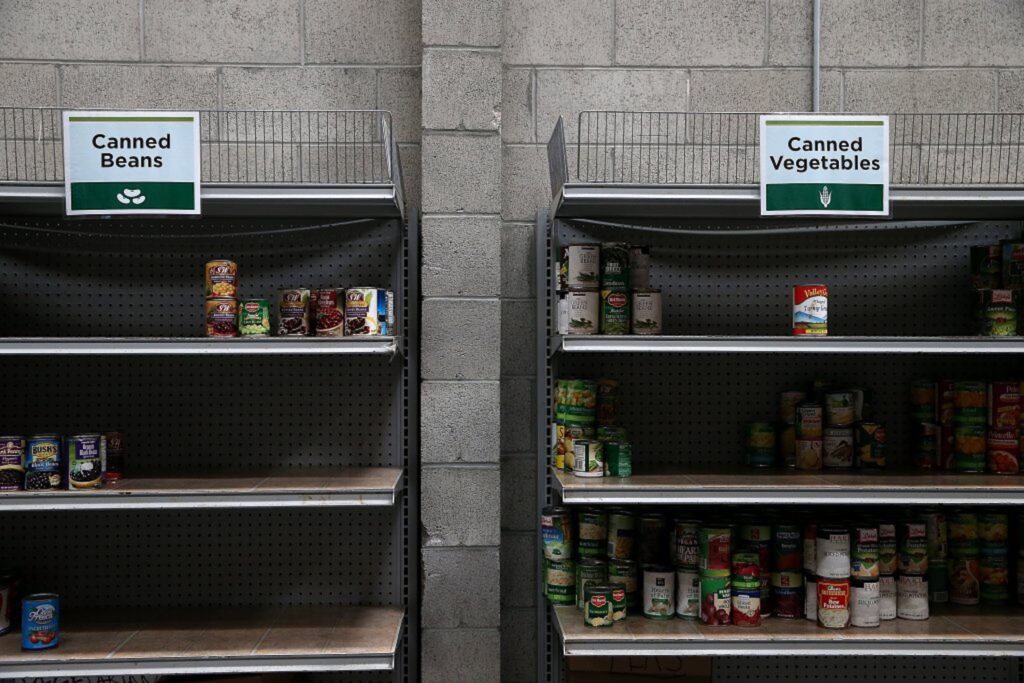Food insecurity can place an increased strain on one’s health status. (Justin Sullivan | Getty Images)
Healthy living situations and communities can lead to improved well-being for all Granite Staters, including through enhancements to economic security.
A person’s health status extends well beyond the individual and is influenced by factors known as the social determinants of health. According to the U.S. Department of Health and Human Services, these determinants are “the conditions where people are born, live, learn, work, play, worship, and age that affect a wide range of health, functioning, and quality-of-life outcomes and risks.” New data from the U.S. Census Bureau provides insights into household incomes, poverty rates, housing costs, and health coverage across New Hampshire, all of which are associated with the social determinants of health.
Having adequate income helps ensure individuals can optimize aspects of their lives that can positively impact health outcomes.
In 2023, the state’s median income rose to about $97,000, which was a rebound to its 2021 level following a decline in 2022, after adjusting for inflation. While the median increased, approximately 25 percent of households had annual incomes below $50,000 in New Hampshire, reflecting many had incomes that fell well short of the median. The Massachusetts Institute of Technology estimates the 2024 living wage income in New Hampshire is $97,876 for two working adults with one child.
According to the Official Poverty Measure, the overall poverty rate in New Hampshire was 7.2 percent in 2023. This rate represented around 98,000 Granite Staters living with incomes below the poverty guidelines, at $24,526 for a household of three with adjustments for household sizes. The 98,000 Granite Staters in poverty is approximately equivalent to the population sizes of Claremont, Concord, Laconia, and Portsmouth combined. Children under 18 and older adults aged 65 and older faced slightly higher poverty rates, at 8 percent and 7.6 percent, respectively.
While New Hampshire had the lowest official poverty rate in the country in 2023, other measures of poverty indicate more significant hardship. According to the Supplemental Poverty Measure, which accounts for certain expenses, taxes and tax credits, benefits, household compositions, and regional housing costs that the typical poverty measure does not, around 7.4 percent of Granite Staters lived in poverty during the 2021-2023 period. This rate was statistically indistinguishable from 19 other states, as well as higher than that of neighboring Maine, which had the lowest poverty rate in the nation, according to the supplemental measure.
Individuals with low incomes are more likely to experience food insecurity, which can place an increased strain on one’s health status. Separate data from the U.S. Department of Agriculture revealed that approximately 42,300 households, or 7.4 percent, were food insecure during 2021-2023. This number was an increase from the estimated 5.4 percent who faced food insecurity in 2019-2021, the lowest rate in the state across the prior two decades. Similarly to the 2021 declines in poverty as measured by the Supplemental Poverty Measure, the decrease in food insecurity during this time likely reflects economic aid provided to families during the pandemic.
Access to safe and affordable housing can also impact health.
In 2023, homeowners had significantly higher median annual incomes than renters, at $114,853 compared to $53,816. In addition to having lower incomes, around 51 percent of renters paid more than 30 percent of their income toward rent and utilities, leaving less income available for other household and health care expenses. Renters with low incomes are also more likely to live in older homes, which can create other household costs and risks to health.
The availability of health coverage can determine how often one is able to engage with the health care system. About 75.9 percent of the New Hampshire population received all or part of their health coverage through private means in 2023, with around 52.8 percent of the state receiving coverage solely through their employer. Approximately 33.3 percent benefited from all or partial public coverage in 2023, most predominantly through Medicare or Medicaid. Despite high coverage rates, approximately 69 percent of Granite Staters reported delaying or foregoing care due to cost, according to survey data from New Futures.
The federal Patient Protection and Affordable Care Act and the subsequent 2014 Medicaid expansion in New Hampshire were key for expanding health coverage among Granite Staters. Temporary policies that expanded access to Medicaid coverage during the COVID-19 pandemic also helped reduce the number of uninsured residents. The state’s uninsured rate decreased from about 10.7 percent in 2013 to 4.7 percent in 2023. However, Granite Staters who identify as Black or Latino, those with low incomes or low educational attainment, and those aged 18 to 44 face higher uninsured rates, reflecting barriers to access and opportunity.
While median incomes have risen and health coverage has remained stable, elevated rates of poverty and food insecurity, combined with increased housing costs, create ongoing challenges for Granite Staters, particularly those with low and moderate incomes. By employing a social determinant lens, New Hampshire can help support the well-being of Granite Staters and build a vibrant economy.

